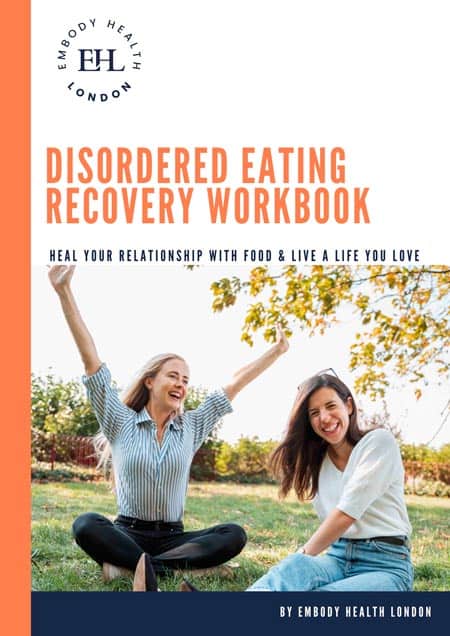Blog

What to do if you can't feel your fullness
A guide to recognising, feeling, and embracing your fullness
‘Feeling your fullness’ is one of the ten intuitive eating principles. This article will explore what this part of the intuitive eating approach really covers and how we can strengthen our interoceptive awareness. This will help us to recognise bodily cues to eat and live more mindfully.
What is interoceptive awareness?
Being aware of our hunger and satiation cues involves something known as interoceptive awareness (IA). Interoceptive awareness is defined as “the ability to identify, access, understand, and respond appropriately to the patterns of internal signals – provides a distinct advantage to engage in life challenges and ongoing adjustments.” (1)
Interoceptive awareness was initially conceptualised by physiologists who measured participants’ heartbeats whilst the individuals calculated their own heart rate without seeing the monitor. (1) Participants with a more accurate estimation were seen to have a higher interoceptive awareness.
In the same way, research has shown participants with this heightened bodily awareness to be more intuitive when it comes to eating. (2) In turn, this could lead to better blood-glucose control and greater mindfulness of emotions and feelings.
Increased interoceptive awareness may help avoid binging or purging episodes where satiety may be overshot and help to improve feelings of regret, disgust, and disappointment that are associated with this.
How can I develop my interoceptive awareness?
Like any skill, you can develop interoceptive awareness with the right tools. Some things you can incorporate into your day include taking moments of mindfulness or meditation, using a hunger and satisfaction wheel or scale, as well as body scans.
What is the hunger and fullness scale?
The hunger and fullness scale can be used to help you describe and learn about how hunger and fullness feel in your body. We are usually good at realising when we are starving or stuffed, overlooking the subtle nuances in the middle of this spectrum. Think of the scale as your body’s fuel tank – we don’t want it to get to zero as we won’t be able to function very well, and a ten on the scale may feel so uncomfortably full that we don’t feel at our optimum either. The scale generally looks as follows:
- 0-2: Over-hunger, starvation
- 3-4: Gentle hunger
- 5-6: Contentment, neutral feelings about food
- 7: Comfortable fullness
- 8-10: Uncomfortable fullness
Keep in mind that this is a general guide, and the above categories might move around a bit for you as you notice more subtleties – we are all unique, after all!
How can I feel my fullness?
Fullness presents itself in many ways: in the head, the body, the stomach, not forgetting the impact it has on our mood and energy levels. When working on feeling our fullness, it can be helpful to look at how we may feel hunger in these areas and work backwards: (3)
- Head: How do your concentration levels feel? Do things feel more focused and clear for you?
- Body: How does your body feel? Are you no longer interested in food, and have you stopped thinking about it? Have you stopped salivating, and have your cravings reduced? How is the pace of your eating – has it slowed down?
- Stomach: Do you feel more comfortable, and are hunger pangs gone? Do you feel slightly bloated, and is there gurgling in your stomach?
- Mood: Do you feel content, calm or happy? How satisfied do you feel?
- Energy: Are you feeling recharged and energised? Maybe you may even feel a little sleepy?
Sometimes we can get fixated on reaching a precise point of fullness and stop as soon as we reach it. It is worth checking where you are on the hunger and fullness scale before, during and after a meal to see where you are approximately. Adopting this level of mindfulness may not be possible at every meal, and when we are busy, it’s better to eat than skip meals. However, when we are given more time and space during mealtimes, try focusing your energy on the sensory aspects of the food and how it makes you feel.
If you are still feeling around a five or six on the scale after a meal, perhaps you could try rounding out the meal with a light snack such as chocolate, biscuits, cheese, fruit or yoghurt to help find a satisfying level of fullness. Check out this article to learn more about the macronutrients that satisfy and serve our bodies and how you can avoid feelings of guilt when it comes to eating.
Our top tips for feeling your fullness:
ONE
Remember that the stomach is a reservoir for food, and after a meal or snack, fullness will go down over time as it empties. At the same time, feelings of hunger will increase again. You can practice being mindful of these cues by checking in every 30 minutes or so to see where you are at. This can be a simple noticing or you can work through the different areas of the body as explained above.
TWO
If you live with high-stress levels, chronic illness, an eating disorder, or are on medication, your hunger and fullness cues may not be quite there yet.
Suppose you don’t experience these cues noticeably or regularly. In that case, it may be worth firstly trying to incorporate more structure around eating – and eating every two to four hours to build up your food intake and appetite.
It can be valuable to seek professional help from an experienced dietician regarding these more complex situations. They can offer you the support you may need to rebuild and add balance to your diet.
THREE
Don’t forget that your body deserves love, kindness and nourishment, and fullness plays a significant role in this. Keep up your fantastic work – you’re doing great!
Priya Chotai, BSc ANutr
EHL Team x
References
- Craig A. D. (2015). How Do You Feel? An Interoceptive Moment with Your Neurobiological Self. Princeton, NJ: Princeton University Press; 10.1515/9781400852727
- 2. Herbert B, Blechert J, Hautzinger M, Matthias E, Herbert C. (2013) Intuitive eating is associated with interoceptive sensitivity. Effects on body mass index, Appetite. [Internet]. 2021 [cited 4 May 2021]. Available from: https://bit.ly/3tnI7Nl
- Thomas, L. Module 2: Reliance on Hunger + Satiety Cues + The ‘Pleasure Principle’, Applying Intuitive Eating + Non-Diet Approaches in Practice, London Centre for Intuitive Eating, 2020.














